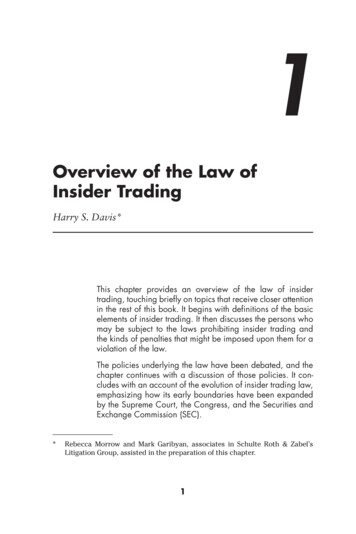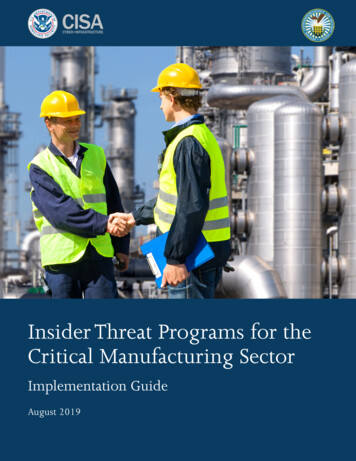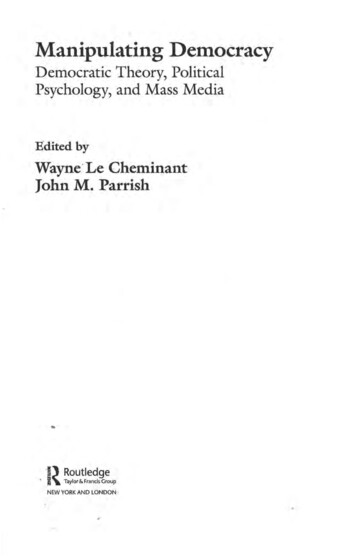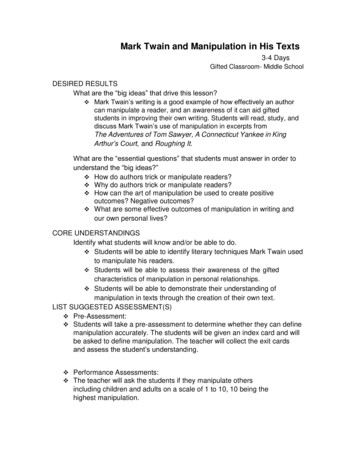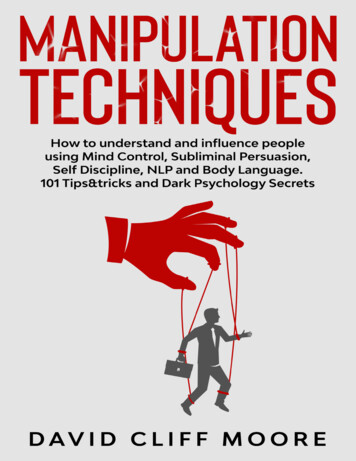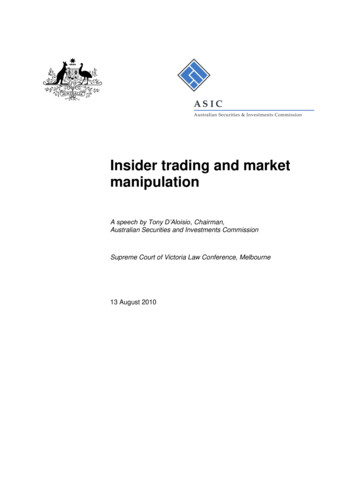
Transcription
Insider trading and marketmanipulationA speech by Tony D’Aloisio, Chairman,Australian Securities and Investments CommissionSupreme Court of Victoria Law Conference, Melbourne13 August 2010
Insider trading and market manipulationIntroductionThank you very much for inviting me along today to speak to you aboutinsider trading and market manipulation. I am delighted to be here—even onFriday the 13th!My objective will be to provide the ASIC perspective in this area. ASIC isthe regulator responsible for detecting, investigating and taking action; forexample, for civil penalties and for delivering briefs to the CommonwealthDirector of Public Prosecutions (CDPP) for criminal proceedings. ASIC canalso seek enforceable undertakings and take administrative actions (e.g.bannings).Until 1 August 2010, ASX had ‘front line’ responsibility for broker ormarket participant oversight and surveillance. That responsibility, from1 August, passed to ASIC. One of the benefits should be to speed up theprocess between detection and, in cases which warrant it, investigation andenforcement. In saying that, it is important to note that ASX carried out the‘front line’ surveillance work very well. The move to ASIC was driven moreby removal of potential conflicts of interest between ASX’s role as a listedcompany and the supervision of the market on which it is listed, particularlyif we move into competition for trading services.In giving you ASIC’s perspective, I will be doing so largely at an ASICpolicy level, focusing on the issues which we are dealing with and ourapproach and priorities.I will not, for example, be focusing on specific legal interpretation issueswithin the relevant provisions themselves. I hope that will not disappoint anaudience such as this which is steeped in analytical rigour (and rightly so)when it comes to the application of the law.Also, in discussing ASIC policy, I will not move into broader policy issueswhich are matters for the Federal Government. This is because, as aregulator, our primary obligation is to work within existing laws and we usethe established channels with Treasury to pass on input and views onpossible changes to those laws. More importantly, however, we are in afederal election period and during this period the ‘caretaker conventions’apply.So let me turn to outlining ASIC’s perspectives in the area of insider tradingand market manipulation.The way I’ll do that is to make and expand on five points and then provideconcluding remarks drawing those points together. Australian Securities and Investments Commission August 2010Page 2
Insider trading and market manipulationI am happy to then take questions and hopefully expand and clarify what I'vesaid and answer questions on issues you wish to raise which I may not havecovered.My first point:The underlying policy of the Corporations Act is(essentially) that markets should be organised in a way thatencourages all investors to trust that they will be treatedfairly. Any appearance that the markets allow insiders totrade using their inside information against investors atlarge will harm that trust and discourage participation inthose markets.Let me expand this point.Much of the underlying philosophy of the Corporations Act is based on thegroup of theories generally referred to as the ‘efficient markets hypothesis’.Markets are left to operate with a minimum of regulation. However, two keyregulatory underpinnings to the operation of the markets are disclosure (‘letthe sunlight in’) and prohibition of certain practices, most notably the insidertrading and market manipulation offences.It is not difficult to see why these prohibitions are needed. When investorshave confidence in the integrity of our markets, the economic benefits can besignificant and are generally well recognised (e.g. lower cost of capital).Conversely, the economic damage caused by offences such as insider tradingand market manipulation can also be significant (e.g. higher cost of capital).While it is commonly accepted that these offences can result in a private lossfor investors (and a private gain for the market abusers), marketmanipulation and insider trading also involve a less easily quantifiable, butnevertheless evident, public cost.What do I mean by public cost? Well, the offenders are unfairly exploiting,for their financial benefit, the inherent information asymmetries betweenwell-informed insiders and less-well-informed market participants, includingretail investors. Both destroy trust in market fairness and efficiency, andrepresent a market failure if they are prevalent.The public cost, which is the harm done to the integrity of the market and toconfidence (i.e. perceptions of the integrity of the market), can lead tochanges in broader market behaviour and pricing, and flow on into otheradverse effects on the economy.Conceptually, the public cost of insider trading and market manipulation canbe expected to be seen in the first instance in a widening in the bid–askspreads for all trading in the securities in question. This can spill over into Australian Securities and Investments Commission August 2010Page 3
Insider trading and market manipulationwidening bid–ask spreads in the market for all securities, an increase in thecost of capital and a reduction in the market price of securities—not only fornew and existing issues of the security in question but also for othersecurities. A reduction in market depth (reflecting reduced willingness totrade) and reduced trading volumes would also be expected.In a dynamic analysis, these higher costs of capital and costs of tradingwould feed into lower returns on investment, less fixed capital spending andless potential and actual economic demand and activity over the economiccycle.Unless they are caught and punished adequately, insider traders and marketmanipulators themselves do not incur much of these economy-wide costs.The conduct also creates a negative externality. Securities prices in themarket are distorted, and consequently other buyers and sellers end uppaying for inefficiencies in the market as a result of the offender’s conduct.There are a number of academic studies which support the view that thereare real economic costs associated with these offences. Similarly, that thereare economic benefits to high levels of market integrity, brought about bystrong enforcement against market misconduct in capital markets.Though the debate about the pros and cons of insider trading and marketmanipulation has been quite contentious in some parts, it seems that from thepoint of view of actual practice, the debate has been settled. In a study ofinsider trading regulations in every country that had a stock market at theend of 1998, researchers in the United States found that 100% of the 23developed countries, and about 80% of the 80 emerging markets, had insidertrading laws on their books (i.e. prohibitions against insider trading).1The same research paper looked at the extent of market integrity in all ofthose 103 stock markets and concluded that, on average, enforcing insidertrading laws resulted in a real reduction in the cost of capital. Interestingly,though, the mere existence of insider trading laws was not itself associatedwith an improvement in market integrity, as measured by cost of equitycapital. It was the enforcement of the laws that mattered.2A 2007 paper by John Coffee generally supported this view and found that—particularly in the United States—a greater emphasis on enforcement helpsreduce information asymmetries in a market and gives it a lower cost ofequity capital.31U Bhattacharya & H Daouk, ‘The world price of insider trading’, Journal of Finance, vol. 57, 2002, pp. 75–107.ibid.3J Coffee, ‘Law and the market: The impact of enforcement’, The Center for Law and Economic Studies, Columbia UniversitySchool of Law, Working Paper No. 304, 4 April 2007.2 Australian Securities and Investments Commission August 2010Page 4
Insider trading and market manipulationMy second point goes to the issue of how clean and fairour markets are.Let me be clear: Australia’s markets are well regardeddomestically and internationally. Indeed, the dailyinvestment and spreads indicate that it is a market wheredomestic and international investors trade with confidencein the integrity of our markets.Let me expand this point.Australia’s markets are robust. The 2009 Johnson Report on Australia as afinancial centre found that the Australian financial sector emerged from theglobal financial crisis strong, well regulated and highly regarded around theworld. For the most part, it is competitive, efficient and innovative inmeeting the needs of Australian households and businesses.4 It also foundthat Australia has arguably the most efficient and competitive ‘full service’financial sector in the Asia-Pacific region.5The report noted that our financial sector ranked highly in internationalsurveys on many of the key requirements for a successful financial centre.These include a highly skilled workforce and a first class regulatoryframework that has served us well through the global financial crisis (GFC).6Through the GFC, Australia remained an attractive market to raise capital.Indeed, Australian equity issuance increased significantly, both in absoluteterms and as a share of global issuance, during the course of 2008 and into2009. In the nine months to September 2009, Australian equity issuance wasthe third largest in the world after the United States and United Kingdom.The ability to raise capital through the GFC, at least for the larger and morecreditworthy companies, was arguably an important factor in limiting theeconomic downturn in Australia.7You simply cannot get these sorts of results unless investors have confidencein the integrity of the central piece of our financial markets—our exchangetraded markets.So why is that? What can we draw from this? Clearly a number of things areworking well: the robustness of our regulatory framework; for the most part, the corporate ethics of our boards and executives andother gatekeepers (e.g. market participants); and4Australian Financial Centre Forum, Australia as a financial centre, Commonwealth of Australia, Canberra, 2009, (hereafterknown as ‘the Johnson Report’), covering letter by the Australian Financial Centre Forum to The Hon Chris Bowen MP, 17November 2009.5The Johnson Report, p.1.6ibid.7The Johnson Report, p.35. Australian Securities and Investments Commission August 2010Page 5
Insider trading and market manipulation ASX’s and ASIC’s track record in detection, investigation andenforcement (included in this are the important roles of the CDPP andthe courts).These things have combined to ensure Australia has markets in whichinvestors can trade with confidence (as they do each day).ASIC’s track recordLet me expand on this last point and focus on ASIC’s track record in the areaof insider trading and market manipulation.Three years ago, as part of our strategic review, we reassessed our resourcesand approach to this area. The significant increase in retail investors in ourmarkets and perceptions (at the time) of insider trading and marketmanipulation led us to increase our resources in this area. We did not engagein a debate on whether or not the perceptions of the prevalence of insidertrading and market manipulation were correct. We thought it was better toincrease resources with the objective of: increasing surveillance and detection; increasing the number of investigations; and focusing more on criminal penalties (because of their greater deterrenceimpact) than civil penalties.How did we do that? What are the results?In late 2007, we put in place, under the leadership of Commissioner Gibson(now Deputy Chairman): a dedicated markets area; and two dedicated market integrity enforcement teams (headed now byChris Savundra and George Stogdale) with 40 full-time equivalent staffin each team working on market integrity cases.In addition: ASIC and the CDPP enjoy a good working relationship, and we havecontinued to improve our approach of working towards a commonpurpose on these and other enforcement issues (always respecting theCDPP’s independence). ASIC has continued to devote resources to increase training anddevelopment of our staff, including additional skills for the legal andother professions. ASIC and ASX have worked more closely together at the detection andinvestigation level. Australian Securities and Investments Commission August 2010Page 6
Insider trading and market manipulationAs we have now assumed the surveillance and supervision responsibilities ofthe markets from 1 August, we have also: established a Markets Disciplinary Panel to deal with breaches of themarket integrity rules by operators and individuals—the panel consistsof very experienced members with many years of industry knowledge;and established the Listed Markets Surveillance team to supervise real-timetrading on Australia’s domestic licensed markets.What is different to the period prior to late 2007 is more in emphasis: ASICdid investigate and prosecute these offences before then, but it did so withinits general enforcement division. This structural change was important togive more direct focus to the area, as was increasing resources.ASIC’s enforcement recordWhat are we achieving? We currently have 69 enforcement matters relatingto market integrity and, since 1 January 2009, we have had 16 significantoutcomes specifically relating to insider trading and market manipulation,including: four outcomes (three convictions and one guilty plea) for insider trading(Panchal, O’Reilly, Stephenson and Hartman); five outcomes (four convictions and one civil penalty) for marketmanipulation (Wade, Musumeci, Newing, Soust and Chan); and seven brokers have also been banned from providing financial services,for having engaged in either insider trading or market manipulation.We have a further eight insider trading and market manipulation matterspending before the court on criminal charges.This is a significant improvement on previous outcomes. In fact, weachieved the same total number of outcomes in the past 18 months as we didfor the previous five or so years in total.8These results are important in sending a clear message that ASIC has thisarea as a priority and it is resourced to detect, investigate and, with theCDPP, prosecute. The effectiveness of this approach is backed by the studiesI mentioned earlier that say strong enforcement is needed if we are tomaintain confidence in the integrity of the markets.You can see from this that ASIC’s (and prior to August, ASX’s) track recordhas been important in maintaining confidence in the integrity of our markets.8There were 16 insider trading and market manipulation outcomes between 1 January 2004 and 31 December 2008. Australian Securities and Investments Commission August 2010Page 7
Insider trading and market manipulationI am not suggesting that insider training and market manipulation has beenstamped out. There will always be room to do more.In the end, however, the best guide remains the market itself. The trading onthe market, and its attraction to international investors, gives us quite adegree of comfort that they have confidence in the integrity of our markets.I should add that our commissioner oversight of the area will continue withCommissioner Shane Tregillis taking over from Commissioner BelindaGibson, who is now focusing on her role as Deputy Chairman after havingled this transition so successfully, as well as the integration of ASXsurveillance into ASIC.My third point:ASIC regards these offences as serious and considers that(generally) they require criminal prosecution to maximisethe deterrent effect.Let me expand on this.Currently, an individual who engages in insider trading in Australia and isfound guilty of a criminal offence is subject to a maximum fine of 220,000and/or five years imprisonment. For market manipulation, the punishment isa maximum fine of 22,000 and/or five years imprisonment.A corporation found guilty of an offence for insider trading is liable for afine of up to 1.1 million. For market manipulation, a maximum fine of 110,000 is applicable.In the civil penalty regime, for both insider trading and market manipulation,an individual is liable for a fine of up to 200,000 and a corporation 1million.It is open to ASIC to pursue civil penalty proceedings instead of criminalproceedings for these offences. In making that assessment, ASIC weighs upa number of factors and works (under an Memorandum of Understanding(MOU)) with the CDPP.Civil penalty proceedings have a number of advantages: they can be pursuedby ASIC itself and not require another agency (CDPP), and they have (onthe face of it at least) a lower standard of proof. In addition, civil penaltyproceedings can provide quicker settled outcomes.Nevertheless, ASIC’s approach in more recent times has been (generally) topursue criminal proceedings for these offences. Although preparation forsuch cases takes longer (necessarily so with a high standard of proof andwhen individual freedom is at issue), ASIC’s view is that criminal Australian Securities and Investments Commission August 2010Page 8
Insider trading and market manipulationproceedings and sanctions, including imprisonment, are what will ‘focus theminds’ of those who may be inclined to stray (so-called ‘generaldeterrence’).The Government recently reviewed the penalties for these offences. Beforethe dissolution of the Australian Parliament, the Corporations Amendment(No. 1) Bill 2010 proposed to increase some of the penalties on the insidertrading and market manipulation offences. The Bill lapsed as a result of thedissolution and calling of the election.For an individual, the proposed penalties for both insider trading and marketmanipulation were to be: the greater of 495,000, or three times the profit gained or loss avoided;and/or up to 10 years imprisonment.For a corporation, the proposed penalties were to be the greater of: 4.95 million; three times the profit gained or loss avoided; or up to 10% of the body corporate’s annual turnover in the relevantperiod.As outlined by the Government, the policy behind these changes was to: add to the deterrence impact; and bring the penalties more in line with those applying to cartel activityunder the Trade Practices Act.There are a number of similarities between insider trading and marketmanipulation offences and cartel activity. At the simplest level, they are each‘white-collar’ crimes where the offender is often involved in the businessthat would benefit from the activity or transaction; they each involveexploiting information asymmetries between well-informed insiders andless-well-informed others; and both destroy trust in market fairness andefficiency.As I said, the Bill has now lapsed. Importantly, if reintroduced and passed, itwould set new levels and, as you know, courts will have regard to these newlevels when applying the principles of sentencing.Overseas markets also view these offences seriously. In the United States, anindividual found guilty of insider trading can receive a fine of US 5 millionor 20 years imprisonment or both. A corporation found guilty of the sameoffence faces a fine of up to US 25 million. While in the United Kingdom, aperson found guilty of insider trading faces up to seven years imprisonmentor an unlimited fine. Australian Securities and Investments Commission August 2010Page 9
Insider trading and market manipulationMy fourth point:When it comes to punishment, ASIC is focusing more onbuilding the case to assist courts in sending (whereappropriate) clear messages on general deterrence.As you know, when sentencing an offender for these offences, the courttakes into account a number of factors—including those outlined in s16A(2)of the Crimes Act 1914.A recent review of insider trading cases (Juliette Overland) has shown thatcourts had most commonly taken into account 17 criteria:1amount of profit made2character of the offender3any expression of remorse or contrition4any extra-curial punishment5general deterrence6manner in which the information was acquired7personal circumstances of the offender8any breach of confidence9manner in which the trial was conducted and guilty plea10 relationship with the relevant company11 any delay in prosecution12 prospects of rehabilitation13 relationship with the securities industry14 specific deterrence15 acceptance of pecuniary penalty order16 amount of money wagered17 any hardship to the offender’s family.9Punishment for insider trading and market manipulation offences has varied,affected principally, of course, by the circumstances of each case. In therecent past, individuals convicted of criminal offences received penalties9J Overland, ‘Towards better deterrence of securities fraud: Promoting consistency in sentencing insider traders’, MacquarieJournal of Business Law, vol. 5, 2008, pp.191–223 at p.196. Australian Securities and Investments Commission August 2010Page 10
Insider trading and market manipulationranging from a 12-month good behaviour bond with a conviction recorded10to three years imprisonment.11In the past 18 months, seven individuals have been convicted of insidertrading and market manipulation offences, and six of them were given asentence of imprisonment. The average head sentence across these cases was16 months imprisonment.In some, but not all, of these cases, the court explicitly considered the impactof the relevant conduct on market confidence and integrity (the broaderissues I discussed earlier) in determining penalties.For example, in R v Hannes [2002] NSWSC 1182, which remains one ofAustralia’s largest insider trading cases in terms of profits made, the courtviewed the investors as victims of insider trading transactions. Moreover, thecourt stated that the defendant’s act had undermined the integrity of thesecurities market and noted that this would lead to a loss in marketconfidence and market efficiency.12This was reaffirmed in R v Rivkin [2004] NSWCCA 7, where the court tookinto consideration the loss of market confidence as a determinant inassessing the quantum of penalty. The court also stated that it intended to useimprisonment as a method of sending out a deterrent message to thesecurities market and those who are engaged in the industry. The courtemphasised the fact that detection in insider trading cases is so difficult thatthe only effective deterrent message that could be sent to the public isthrough penalties and sentencing.13In that case, Mr Rivkin was convicted of insider trading and sentenced tonine months imprisonment, to be served by way of periodic detention, andfined 30,000.More recently, in this court, Justice T. Forrest has passed sentences in bothan insider trading case and a market manipulation case—DPP v O’Reilly[2010] VSC 138 and R v Chan [2010] VSC 312 respectively. In O’Reilly, hisHonour stated (at [19]):In insider trading cases I consider there are at least two victims; the selleror sellers of the stock at the lower price and the public, whose confidencein the integrity of the market must be diminished. The impact upon publicconfidence in the market is an important factor. The securities marketscould not survive and flourish without the confidence of those who elect toinvest in it.10In 2010, Mr Noel James Stephenson was convicted after pleading guilty to an insider trading charge brought by ASIC. JusticeFullerton convicted Mr Stephenson and released him without passing sentence by recognisance on the conditions that he be ofgood behaviour for 12 months and pay to the Commonwealth a pecuniary penalty in the sum of 20,000 by 31 July 2010.11In 2007, Mr Dean Scook was convicted on 158 counts of market rigging and was sentenced to three years imprisonment, tobe released after serving 14 months, upon giving a personal recognisance of 5,000 surety to be of good behaviour for thebalance of the term.12R v Hannes [2002] NSWSC 1182 at para 90.13R v Rivkin [2004] NSWCCA 7 at paras 412 and 423. Australian Securities and Investments Commission August 2010Page 11
Insider trading and market manipulationMy fifth and final point:In the running of insider trading and market manipulationcases, assembling evidence to prove to the requisitecriminal standard (because of the nature of the offences)continues to be a challenge for ASIC but one that it iscontinuing to meet.Let me expand on the ongoing challenges for ASIC on satisfying therequisite standard of proof when bringing insider trading and marketmanipulation cases.Insider trading and market manipulation offences are difficult to prove. Thiscan be evidenced by the limited number of actions taken by regulatorsaround the world. It is interesting to note that until 1990 only nine countrieshad brought any charges on breaches of insider trading laws.14Some of the challenges with evidence collection in insider trading andmarket manipulation cases include: detection of suspect trades can be difficult, particularly during heavytrading (by way of indication, in today’s electronic world a significantnumber of messages, such as offers, can be sent in one second); distinguishing manipulative from legitimate trading—particularly wherethere is a high volume of trading and algorithmic trading; there is often little in the way of a document trail when the offenderengages in insider trading or market misconduct—proving possessionof insider information can therefore be very difficult; obtaining witnesses to prove the communication of price-sensitiveinformation between an insider and a trader in an insider trading case;and in some cases, the difficulty goes beyond possession of the insideinformation to proving whether the information a person possessed is‘material’ as defined by the legislation.In a recent paper on the continuing problems of proof in insider tradingcases, one commentator (M. Duffy) summarised the challenges: 14Regulators will often find themselves in a position where they canidentify a person with inside information on a particular security, aperson who traded in that security, a relationship between the twopersons and even evidence of communications between them (such astelephone records).U Bhattacharya & H Daouk, ‘The world price of insider trading’, Journal of Finance, vol. 57, 2002, pp. 75–107. Australian Securities and Investments Commission August 2010Page 12
Insider trading and market manipulation This may still not be enough unless there is some evidence of thecontent of the communications. Though a circumstantial case for communication may exist, it is usuallynecessary to establish what was said to identify it as price sensitiveinformation. 15These evidentiary difficulties can become even more pronounced when thealleged offender, or some aspect of the conduct, is located in a foreignjurisdiction and evidence collection must be sought through availableinternational mechanisms, such as the IOSCO Multilateral Memorandum ofUnderstanding on Consultation and Cooperation and the Exchange ofInformation.Now you may say (and quite rightly), ‘So what?’ ASIC is the regulator and itneeds to meet the standard of proof. That’s fair enough. I am raising theissue, however, to assist in dealing with public or community expectations.Often the public’s (or media’s) information is a sharp movement in a shareprice and an event at about that time. A number of assumptions are thenmade and often a connection is made that the event caused the movementand that there must have been inside information. Those in the room knowthat a lot of proof is needed to make these links and to assemble theevidence. In a significant number of these situations, we know fromexperience, that the movements are explained by other factors or factorswhich did not involve inside information. The degree of difficulty and timethat these cases take is not widely appreciated.These expectations on swiftness and speed are no doubt reinforced by suchfilms as Wall Street: the drama of a young man’s seduction by insidertrading, together with the presence of the high-profile Gordon Gekko and, inthe end, swift justice.Reality is different. On any given day there will be a range of queries wewill make (and before us, ASX made) of market participants. Some of thesewill lead to further review and some to investigation, and ultimately somemight get to prosecution. The process does not have the glamour of WallStreet. It is, like other ‘police’ work, painstakingly detailed and with due andproper processes. That is what we believe the community expects. And beingon ‘the beat’, so to speak, in this way is also important in disrupting potentialmisconduct.15M Duffy, ‘Insider trading: Addressing the continuing problems of proof’, Australian Journal of Corporate Law, vol. 23, 2009,pp.149–177 at p. 155. Also refer to S Rubenstein, 'The regulation and prosecution of insider trading in Australia: Towards civilpenalty sanctions for insider trading', Company and Securities Law Journal, vol. 20, 2002, pp. 89–113 at p. 107. Australian Securities and Investments Commission August 2010Page 13
Insider trading and market manipulationEvidence and proofLet me make some other comments on evidence and proof. Clearly, directevidence (e.g. a phone call) can be very useful in these cases.CAMAC published a report in June 2009 (known as the ‘Aspects of MarketIntegrity Report’). In it, CAMAC recommended that insider trading andmarket manipulation offences be included within the definition of ‘seriousoffence’ in the Telecommunications (Interception and Access) Act 1979,which would permit existing ‘interception agencies’ as defined in that Act,such as the Australian Federal Police (AFP), to apply for warrants tointercept telephone conversations for the purpose of investigating suchoffences.16Following this, the Government included a reform to this effect inthe Corporations Amendment (No. 1) Bill, which I have
insider trading regulations in every country that had a stock market at the end of 1998, researchers in the United States found that 100% of the 23 developed countries, and about 80% of the 80 emerging markets, had insider trading laws on their books (i.e. prohibitions against insider trading).1 The same research paper looked at the extent of market integrity in all of those 103 stock markets .


